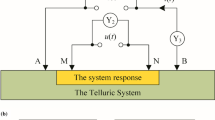Abstract
To reduce noise during electrical prospecting, we hereby propose a new method using correlation identification technology and conventional electrical exploration devices. A correlation operation can be carried out with the transmitted pseudo-random sequence and received time signal to suppress the random noise, and the time-domain impulse response and frequency response of the frequency domain of the underground media can be obtained. At the same time, using a dual Cole–Cole model to fit a complex resistivity spectrum, which is close to the frequency response, we can get a variety of induced polarization parameters and electromagnetic parameters of subsurface, which can provide more useful information for the exploration of mineral resources. This time domain prospecting method can effectively improve the efficiency of the spectral induced polarization method. In this article, we have carried out theoretical calculations and a simulation to prove the feasibility of such a method.




Similar content being viewed by others
References
Duncan P. M., Hwang A., Edwards R. N., Bailey R. C., and Garland G. D. (1980), The development and applications of a wide band electromagnetic sounding system using a pseudo-noise source, Geophysics 45, 1276–1296.
Li Bainan, The pseudo random signal and the correlation identification (Science Press, Beijing 1987) (in Chinese).
Liu Jingxian. Study on the m-sequence correlation identification and its application to induced polarization prospecting for the method of suppressing noise. [MA thesis]. Beijing: China University of Geosciences, 2010 (in Chinese).
Liu Song, SIP method (China University of Geosciences Press, Wuhan 1998) (in Chinese).
Luo Yanzhang, and Zhang Guiqing, Theory and application of spectral induced polarization (Society of Exploration Geophysicists 1998).
Luo Weibin. Study on Pseudorandom marine controlled-Source electromagnetic sounding with multi-offsets. [PhD thesis]. Changsha: Central South University, 2007 (in Chinese).
Luo Weibin, and Li Qingchun (2009), Electromagnetic Exploration Based on System Identification for Seafloor Hydrocarbon Reservoir and Gas Hydrate, PIERS Proceedings, 1344–1348.
Prasad Tadepalli Rammohan, Ramayya Boppana Dasaradha, Rao Yelamanchili Purnachandra. Process and device for measurement of spectral induced polarization response using pseudo random binary sequence (PRBS) current source. US Patent 2010/0102822 A1.
Pelton W.H., Ward S.H., Hallof P.G. et al. (1978), Mineral discrimination and removal of inductive coupling with multi-frequency IP, Geophysics 43, 588–609.
Quincy E. A., Rhoades Mark L., and Sturm Kim A. (1980), Remote Induction Sounding of Hanna Underground Coal Burn 11, Phase 1, Employing Pseudo noise Cross-Correlation Techniques, Transactions on Geoscience and Remote Sensing, 18, 337–347.
Ziolkowski A., Hobbs B.A., and Wright D. True amplitude transient electromagnetic system response measurement. WO2006/114561_A2, 2006-11-02.
Ziolkowski A., Hobbs B.A., and Wright D. (2007), Multitransient electromagnetic demonstration survey in France, Geophysics, 72, 197–209.
Ziolkowski A. Optimization of MTEM parameters. US2009/0230970_A1, 2009-09-17.
Acknowledgments
The research reported in this paper was funded by SinoProbe-01-01 (Experimental study of the continental standard grid of electromagnetic parameters). Special thanks are extended to the authors who made original contribution to the theory and application of pseudo-random sequence in electrical prospecting, e.g. Duncan P. M., Quincy E. A., Hobbs B., Ziolkowski A., Wright D., Prasad T. R. and Liu Jingxian, etc.
Author information
Authors and Affiliations
Corresponding author
Rights and permissions
About this article
Cite this article
Li, M., Wei, W., Luo, W. et al. Time-Domain Spectral Induced Polarization Based on Pseudo-random Sequence. Pure Appl. Geophys. 170, 2257–2262 (2013). https://doi.org/10.1007/s00024-012-0624-z
Received:
Revised:
Accepted:
Published:
Issue Date:
DOI: https://doi.org/10.1007/s00024-012-0624-z




